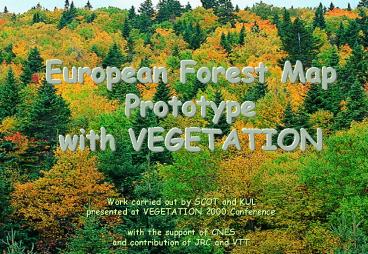Forest Mapping with VEGETATION - PowerPoint PPT Presentation
1 / 26
Title:
Forest Mapping with VEGETATION
Description:
Data : 21 composites S10 from April 1999 to October 1999 ... October 1999. Status map. Clouds in dark blue. Ice in light blue. Bad SWIR sensors in red ... – PowerPoint PPT presentation
Number of Views:345
Avg rating:3.0/5.0
Title: Forest Mapping with VEGETATION
1
European Forest Map Prototype with VEGETATION
Work carried out by SCOT and KUL presented at
VEGETATION 2000 Conference with the support of
CNES and contribution of JRC and VTT
2
Objectives of the study
- Assessment of the capabilities of VEGETATION for
mapping forest at regional scale - Preparation of a European forest map prototype
- with simple methods applied to standard VGT
products (10 days composites S10)
- Partners
- JRC methodology as developed for FMERS study
- KUL alternative approach for stratification
- SCOT processing
- VTT clustering method
3
Processing steps
- Data 21 composites S10 from April 1999 to
October 1999 - Other data CORINE LC, JRC/FIRS stratification
of European forest ecosystems
4
Processing steps
- Quality of VEGETATION S10 data
- High visual quality
- However
- problems of SWIR sensors
- cloud mask to be improved
- remaining directional effects
5
- S10 decade 2
- October 1999
- NIR/SWIR/R
6
- S10 decade 2
- October 1999
- NIR/SWIR/R
7
Processing steps
- Mapping procedure
- Stratification
- utilisation of FIRS strata
- alternative using landscape criteria
- Spectral clustering
- Selection of the most appropriate S10 for forest
types discrimination and generation of a
multi-spectral monthly composite - Stratified clustering of the monthly composite
- Multi-temporal analysis of NDVI forest types
8
Stratification
Two alternative location of cluster means in
three ecosystem regions. A - means similarly
distributed - no likely need for pre-clustering
stratification. B - cluster means on the average
different in different regions - a likely need
for pre-clustering stratification.
9
Stratification
FIRS stratification superimposed over VGT S10
2 October 1999
10
Stratification
FIRS main regions after regrouping of main strata
11
Stratification
- Stratification alternative using landscape
criteria
- fragmentation patterns, e.g. Shannon index...
- proportion of main land cover categories
12
Spectral clustering
- Generation of a monthly composite
- remaining clouds in all S10 products
- selection of three S10 composites
- D3 August 1999
- D1 September 1999
- D2 September 1999
- averaging procedure with elimination of bad
pixels in the SWIR band and remaining cloudy
pixels
13
Spectral clustering
- Generation of a monthly composite
10 days composite 3 August 1999
monthly composite (3 Aug / 1 2 September
1999)
14
Spectral clustering
15
Clustering
- Unsupervised clustering within each stratum into
50 classes - algorithm developed by VTT (Finland) and tested
in the framework of FMERS for European forest
mapping with IRS-WiFS data - based on homogeneous signatures within 2x2 pixels
- automatic sort of the clusters according to their
approximate biomass values
16
Clustering
Likely location of the target classes in the
spectral range (FMERS/VTT)
17
Clustering results
- Unsupervised clustering within each stratum into
50 classes
15
20
18
Clustering results
19
Results
- contribution of the SWIR band
20
Results
- NDVI temporal profiles
- definition of temporal indicators
- distinction of three seasons for better
discrimination of NDVI profiles related to forest
types
- application to the 21 S10 composites
21
Colour composite NDVI three seasons
22
Results
- Temporal profiles of main forest cover types
23
Results
- Temporal profiles of other land cover types
24
Results
- Temporal profiles of CORINE classes
- Quality of CORINE classes ?
- Variability of vegetation phenology within broad
land cover classes
25
Prototype of a European Forest Map derived
from VEGETATION data
26
CONCLUSIONS
- VEGETATION S10 products of very good quality
geometry, radiometry - but some improvements are still needed
correction of directional effects, cloud masking - the spectral clustering approach is leading to
promising results with simple methods and a few
S10 products - dramatic potential of NDVI temporal profiles for
discriminating vegetation types combination
with spectral clustering ? - need to improve and develop new standard products
on NDVI profiles, e.g. phenology, - products on land cover changes

